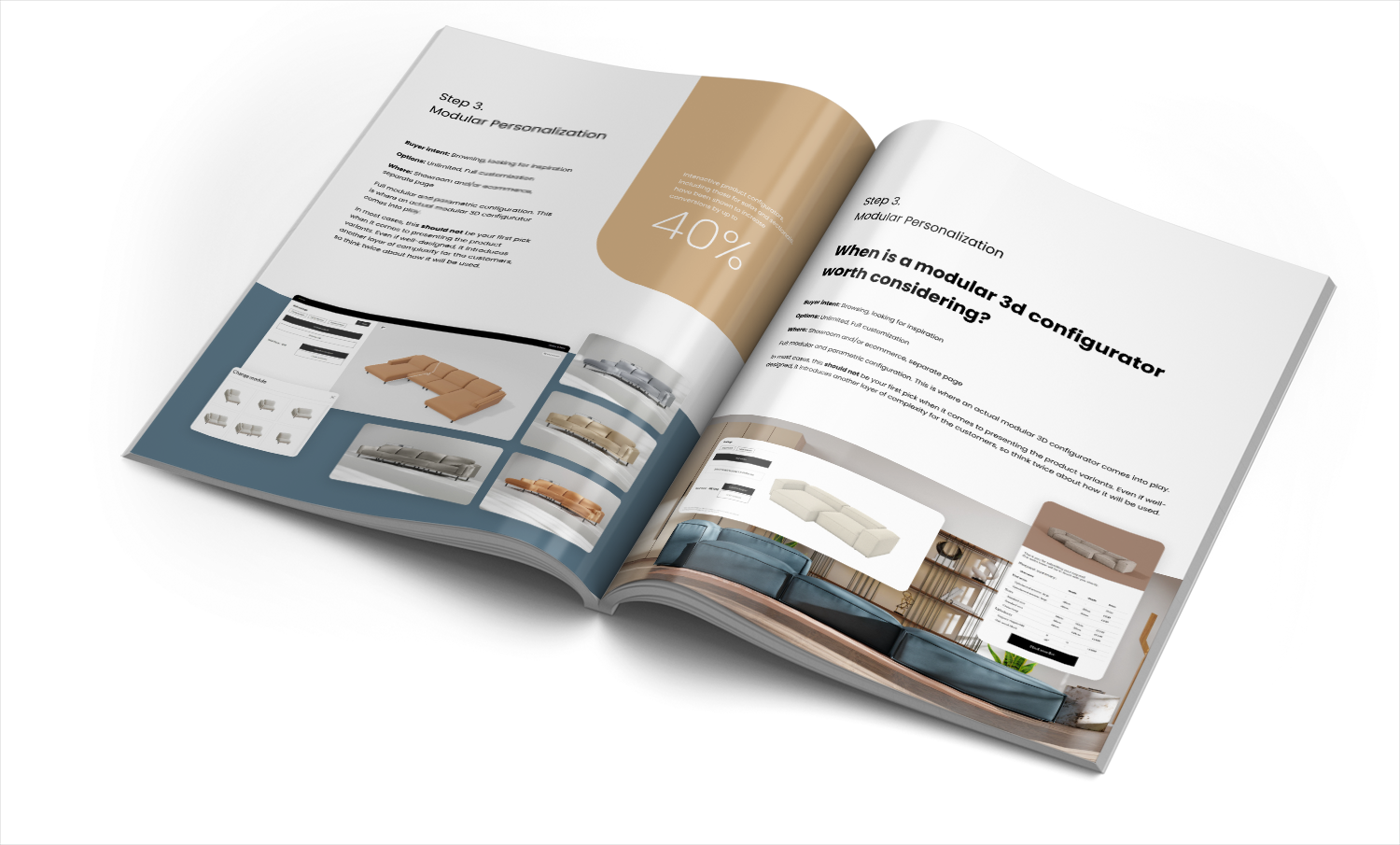The Ultimate 2025 Sofa Configuration Guide
Get your free copy todayy!

A furniture configurator is like a digital showroom assistant. It lets a customer mix and match finishes, dimensions, and modules until the piece feels like it’s theirs. In essence, a product configurator is a digital tool that helps people visualize and customize a product before buying it online.
But not all configurators are the same. Some are simple - they rely on pre-rendered variant visuals, showing how a sofa or a bed looks in each available finish. Think of it as a carousel of ready-made photos directly on your ecommerce product page. That works perfectly when your customization options are limited to fabrics, legs, and colors. No extra complexity for the buyer, and no massive tech stack on your end.
Other times, you need something more interactive. That’s when 3D configurators come in. Here’s where I often point people to our own explainer on the difference between 3D configurators and variant visuals. Sometimes a hybrid approach is best: combining the speed of pre-rendered visuals with the flexibility of 3D logic.
Whether you’re selling sofas or shelving, the right configurator fits both your business process and how your customers prefer to explore.
When we talk about 3D furniture configurators, we usually mean one of two kinds: modular or parametric. Each serves a very different purpose.
A sofa configurator is the poster child here. The user builds from modules - straight, corner, chaise, or pouf - linking them like digital Lego blocks. The system knows which modules fit together and instantly updates visuals and pricing. The customer can sit with their tablet and design their living room centerpiece in minutes.
Parametric configurators are driven by numbers rather than modules. A shelving configurator, for instance, allows customers to tweak height, width, and depth values on the fly. The same logic applies to tables, desks, or beds. Each numeric input reshapes the product in real time. Parametric systems are perfect for brands offering made-to-size solutions where visual accuracy meets manufacturing precision.
And here’s something most brands don’t realize - going 3D doesn’t mean compromising on image quality. With tools like our Custom 3D Product Configurator, we automate photorealistic (raytraced) renders even for modular or parametric setups. Customers get realism, not compromise.
If you’re curious to see what that looks like in practice, the 3D Configurator for Shelving System by Modern Shelving is a great real-world example. It bridges ecommerce usability with professional-grade visual precision.
A great configurator is more than eye candy - it’s part of your technology ecosystem. The best ones plug directly into your ecommerce, ERP, CRM, and PIM systems so everything stays in sync. Pricing updates instantly. Stock availability shows in real time. Orders flow automatically to your production or quoting platforms.
Integration is where many projects struggle, which is why we built a dedicated integration strategy guide to help brands connect all dots smoothly.
Technological capabilities also define whether your configurator fits showroom or online use. In a showroom, a slightly more complex bed configurator may make sense - sales consultants can guide the customer. Online, however, simplicity wins. Each additional step a customer has to take increases the chance you lose them.
Some brands also combine AR (augmented reality) with configurators, letting customers project their chosen design into their own homes. This hybrid approach - merging tactile showroom confidence with digital convenience - often delivers the best results. It expands reach without losing the emotional connection to the product.
Before investing, decide what role your product configurator should play in your sales process. There are two main types.
Lead Pre-Qualifier
Imagine you’re selling fully bespoke wardrobes. The buyer enters dimensions, finish preferences, and budget. The configurator shows an estimated look and price - close enough to qualify the lead but not precise enough for checkout. You still send a designer to confirm the final measurements, but you’ve already captured intent and filtered out casual browsers.
Sales Configurator
In contrast, a furniture configurator like the one at Modern Shelving lets the customer design, price, and order immediately. Every component is predefined, options are validated, and the checkout button is the final step. That kind of configurator becomes part of your ecommerce engine, not just a pre‑sales tool.
To choose between them, look at your product complexity, sales model, and customer expectations. I’ve seen companies struggle when they tried to make a bespoke tool behave like an online store. Clarity on purpose simplifies everything.
For proof of how much performance matters, take a look at Increase your sales with our 3D furniture configurator in 2023. It shows measurable lifts in engagement, conversion, and customer satisfaction across multiple retail contexts.
Selecting the right configurator isn’t about chasing the latest tech trend. It’s about clarity: where the tool lives, how customers use it, and how it fits your operations.
Here are a few points I always tell brand leaders to think about:
Common pitfalls? Complex user interfaces, unsynced pricing data, and lack of clear ownership between marketing and production teams. Most guides say any configurator can work anywhere, but in practice it only works when it’s tailored to your process.
Finally, measure results. Track conversion rate, average order value, and returns. Treat the configurator like any other profit-driving asset, not just a UX experiment.
And if you’re exploring where to start, check out our Ultimate 2025 Sofa Configurator Guide. As much as it mainly focuses on sofas, you’ll find some valuable insight on configurator types in general.
Configurators are no longer just fancy visual tools. They’re decision engines that shape how people buy furniture in the hybrid world of online-offline commerce. Take a critical look at your current systems, find your true goals, and build the experience that makes buying simpler - not more complicated.